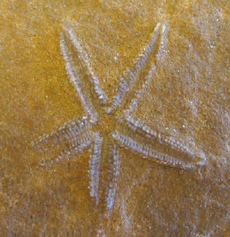
 |
 |
Science
Olympiad
| Phylum Echinodermata | |
| Echinoderms
(phylum Echinodermata-"spiny skin") are one
of the most numerous of marine phyla. Starfish, brittle
stars, sea
cucumbers,
sand dollars, and sea urchins are important members of
most ocean floor communities. Brittle stars and sea cucumbers
are the most common animals on the deep abyssal plains
of the ocean (Prothero, 1998, p. 310). As important
as echinoderms are in today's marine realm, the living classes
represent
but
a
small remnant
of their past diversity. Evolutionarily, echinoderms are
important in yet another way. Among invertebrates echinoderms
may be our closest relatives. Echinoderms & Chordates Echinoderms
were one of the first deuterostomes to appear in the fossil
record. Animals
more complex than cnidarians are split into two major taxonomic
groups based upon their embryonic development, the protostomes
and deuterostomes. Protostomes include flatworms, roundworms,
segmented worms, rotifers, arthropods, and molluscs. Deuterostomes
include invertebrate chordates, echinoderms, and vertebrates.
In deuterostomes the blastopore becomes the anus, while in
protostomes it becomes the mouth. Echinoderms were the first
animals to develop an internal skeleton. Both their embryonic
development and their endoskeleton lead scientists to the
conclusion that echinoderms and chordates were derived from
a common ancestor. Echinoderms
are strictly solitary, marine organisms. Echinoderms
exhibit bilateral
symmetry in their free-swimming tornaria larvae. As
adults most exhibit pentameral or radial symmetry.
Some, such as irregular sea urchins and sand dollars, have
a secondary bilateral symmetry superimposed over a
radial symmetry. Echinoderms
make their first appearance in the Cambrian. Echinoderms
underwent an adaptive radiation during the Ordovician
reaching their peak in diversity. Echinoderms
provide important clues to past ecological conditions.
Echinoderms are strictly marine organisms. Their form
and function is related to the depth at which they
lived and to the structure and conditions of the sea
floor.
|
|
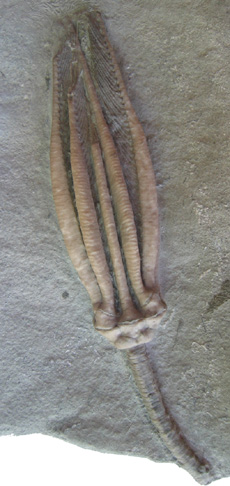 Crinoid Montgomery County, Indiana Edwardsville Formation Paleozoic; Mississippian 12 cm long x 2.5 cm at widest |
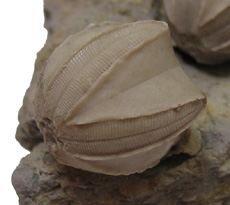 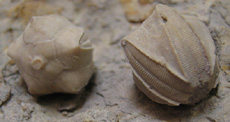 Blastoids Montgomery County, Indiana Edwardsville Formation Paleozoic; Mississippian Specimens are 2 cm long x 1.5 cm wide |
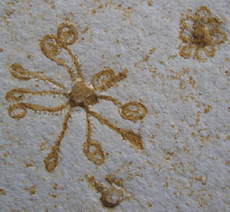 Floating Crinoid Saccocoma pectinata Solnhofen Limestone Late Jurassic Germany 3 cm across |
|
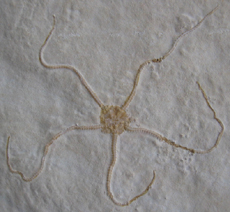 Brittle Star Solnhofen Limestone Late Jurassic Germany 5 cm across |
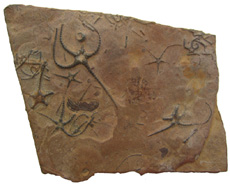 Brittle Stars Jurassic France Large specimen 3 cm |
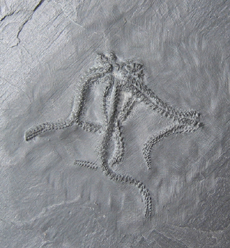 Brittle Star Urasterella asperula Lower Devonian Budenbach, Germany Specimen is 3 cm x 3.5 cm |
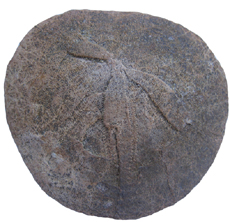 Sand Dollar Tertiary Kettleman Hills Coalinga, California 4 cm |
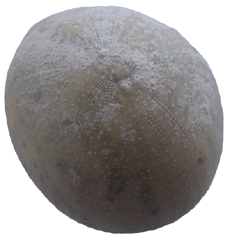 Sea Urchin Echinocorys vulgaris Cretaceous, Campanian Alemannia Quarry, Hoever Hannover Lower Saxony, Germany 7 cm long |
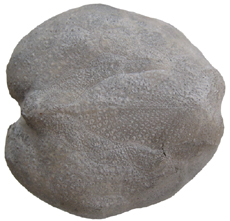 Sea Urchin Heart Urchin Micraster kunolus Cretaceous Germany 6 cm long |
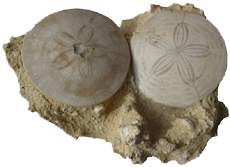 Fossil Sand Dollars Oligocene Bordeaux, France Specimens are 6.5 cm in diameter
|
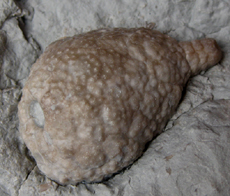 Cystoid Holocystites scutellatus Silurian Niagaran Formation Osgood Shale Napoleon, Indiana 4 cm long x 2.5 cm wide |
Bibliography |
|
Pinna, G. (1990). The Illustrated Encyclopedia of Fossils. New York: Facts on File. Prothero, D.R. (1998). Bringing Fossils to Life: An Introduction to Paleobiology. New York: McGraw-Hill. Prothero, D.R. (2004). Bringing Fossils to Life: An Introduction to Paleobiology [2nd edition]. New York: McGraw-Hill. Rich P.V., Rich T. H., Fenton, M.A., & Fenton, C.L. (1996). The Fossil Book: A Record of Prehistoric Life. Mineola, NY: Dover Publications, Inc. |
|











